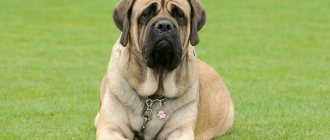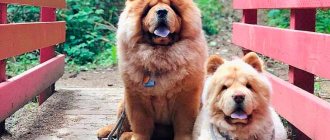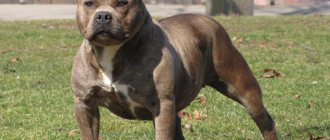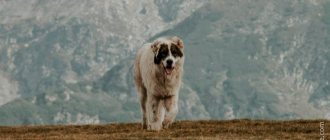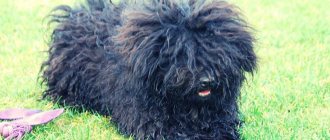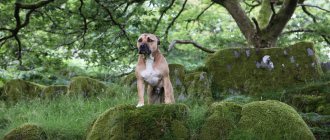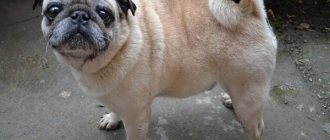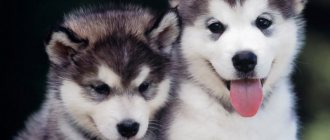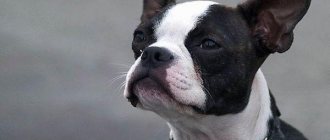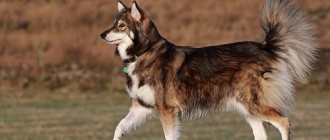Modern young people have no longer seen the era of Karandash, the legendary Soviet clown. However, in the middle of the last century, the artist was very popular. The appearance of this man with his famous dog Blob in the circus arena caused great delight among all spectators.
Reference! Mikhail Nikolaevich Rumyantsev (1901-1983) - People's Artist of the Soviet Union, Hero of Socialist Labor. He performed under the creative nickname Pencil. He devoted his entire life to a circus career and left a good, cheerful memory of himself. The artist made a huge contribution to the development of clownery, creating a new approach to circus art. His compatriots even called him the Russian Charlie Chaplin.
Pencil Dog
The legendary duo of the Soviet circus
Rumyantsev worked in the circus arena for a little over 55 years. The presence of his name on the poster always meant a full house. At first he acted as a tramp, invented by Charlie Chaplin, but since 1935 he created a new unique comic image, named after the famous French cartoonist Caran D'ash.
The Soviet clown rarely went out in public without his funny little dog. Their joint performances created a real sensation. All spectators, especially children, rejoiced at the performance of the legendary clown’s trained dog. They waited impatiently for intermissions to get closer to the dog, touch it, look at it and stroke it. This inseparable duet remained forever in the memory of the audience, although the artist did not immediately have a four-legged partner.
The joint performances of Blobs and Pencil created a real sensation
Character of the Scottish Terrier
Its popularity was contributed not only by its original appearance, but also by its peculiar character, which was called by dog breeders - “terrier-ego”. Behind the appearance of a prim gentleman, Scottie hides the soul of an adventurer, ready to play mischief. Having gone from a burrow hunter to a pet, the terrier did not relax at all. These are the smartest dogs.
Animals behave very independently, but if you have established contact with them, you will not find more obedient pets. They never impose their society. If you call them, they will be happy to respond to your request. But if you don't want to communicate, they won't bother you.
Even an extraordinary situation cannot baffle Scotch. Many terriers do not know what a wild animal looks like, despite the fact that they retain their stubborn character, agility and dexterity of their ancestors. To turn a terrier into a salon dog means to deprive it of the properties inherent in nature itself, to insult the very essence of the dog.
Even though they have strong, short legs, their energy is in full swing. They can share it without infringing themselves. Their fiery temperament will baffle even hounds. Once you release them into the meadow, they rush like the wind. All dogs love to run around in the fresh air. Despite their beautiful show coat, at heart they remain rural and rural dogs.
Scotch is one of the few breeds that has a sense of humor and is capable of pranks towards its fellow dogs. They can just play pranks with the neighbors' dogs. Although nowadays they are kept as companion dogs, their hunting instinct makes them chase birds and cats. They will not harm them, the main goal is to catch up with them. They behave decently with children.
They are endlessly loyal to their owner and are ready to accompany him anywhere. They will give him their big hearts, without a trace. They will share both joys and troubles with him. The small compact dog contains the nature of a lion. Innate tact and courtesy, combined with self-esteem, brought him the fame of a gentleman dog. They are brave and independent. They are distinguished by intelligence and the ability to make independent decisions. It was he, the miniature hunter of the Scottish Highlands, who defended the right to become the national breed of Scotland.
How did the Blob appear?
At the beginning of his career, the clown performed alone, but wanted to make a shaggy friend for himself long before his appearance. Rumyantsev dreamed of complementing his stage appearance with a pet that would be as harmonious as possible with his own image. It’s not for nothing that they say that dogs usually look like their owners. Moreover, Karandash was initially sure that it must be a black mongrel.
The selection lasted a very long time: the dogs were either too small, or, on the contrary, huge. It is worth noting that the artist’s height was only 142 centimeters, so finding an animal of a suitable size was indeed not the easiest task.
Blob and Pencil matched the stage image as best as possible
Such a dog was found absolutely by accident - one of the neighbors in a communal apartment brought it in the late 30s. The black terrier named Nix immediately suited Karandash, as if they had worked together in the arena all their lives, and became a bright completion of his stage image.
Seeing this dog, Rumyantsev immediately decided to include him in his circus acts. Under the guidance of the artist, who at that time was not yet famous and honored, the pet began to earn its own food.
The nickname “Blob” was suggested by Rumyantsev’s wife. One day she saw the dog sitting on a bright red circus carpet and noted that it looked like a large inkblot. Pencil approved his partner's new stage name, and since then the dog has always entered the arena under the name Blob.
Training and training the Roosevelt dog
When raising and training a dog, it is necessary to take into account the characteristics of its character. She does not show excessive activity, she will not jump and bark around the owner, as in puppyhood. But the terrier will appreciate a restrained, intelligent manner of communication and will gladly fulfill all the requirements.
The dog has his own opinion regarding the requirements . They obey only a command that is reasonable, from their point of view. That is, Scotty’s orders are discussed, and he will not tolerate the owner’s tyranny.
Like a child, the Scottish Terrier easily learns the necessary training program, as if playing, it should be interesting for him.
If the owner beats the dog and shouts rudely, then the proud character of the Scottish ancestors and the snobbery of the English gentleman will appear in full glory. The dog will “forget” even what he performed perfectly before.
If you find the right tone of relationship with the dog, then it will learn with pleasure and even zeal, solely out of respect for the owner.
Did you know? Scottish Terrier Fala, President Roosevelt's dog, was part of his image. It was she who made the breed popular.
A terrier needs to be trained constantly. The dog is prone to waywardness. From time to time he needs to be reminded that if it is forbidden to lie on the sofa, then it is always forbidden, and not when Scotty himself does not want to.
Breed Blobs
Despite the fact that Rumyantsev wanted to choose a mongrel for himself, his stage partner was a purebred Scotch Terrier.
Scotch Terrier dog
The black Scottish terrier with a large head, funny protruding ears and a characteristic beard not only looked great on stage, but was also easy to train. The audience's delight at his incomparable performances was simply indescribable.
Scottish Terrier Health
A valuable quality of Scottish terriers is their excellent health, which is justified by their unpretentiousness in food and maintenance. Typically, dogs of this breed do not exhibit hereditary ailments, except that convulsions occur after prolonged exercise. If this is noticed, you should consult a veterinarian and further limit the dog’s activity to reasonable limits.
Scotch puppies are advised to be checked for jaw joint disease VWD, and signs of allergies are observed. In your diet, you should limit the consumption of sweets and starchy foods, which lead to obesity, problems with the intestines and teeth.
Interesting Facts
- On Efremova Street, next to the Union of Circus Workers of Russia, where the artist lived and worked, a bronze monument to the famous duet was erected in the 90s of the twentieth century. The sculptural composition depicts the clown Rumyantsev, dressed in a green suit with a comical hat, and next to him is a small Scotch terrier dog.
Monument to Pencil and Blot
Still from the cartoon “Jolly Hunters”
How much does it cost and how to choose a puppy?
Buying a purebred Scotch Terrier puppy is not a problem, even though the breed is not very popular. Their cost varies from 20 to 45 thousand rubles. The price mainly depends on the fertility of the parents and the status of the nursery. The class of the puppy also matters - future exhibition champions are many times more expensive than babies who will not be allowed to breed in the future.
Therefore, it is worth deciding in advance what you need a Scottish Terrier for. If you just need a faithful friend and you are not interested in his future status, you should not chase a rich pedigree. It is enough that the puppy does not have genetic diseases and is cheerful, healthy and sociable.
Description, characteristics of the Scotch Terrier
Dogs of the Scottish Terrier breed, or Scotch Terrier, are distinguished by their docile nature, original appearance and intelligence. These are energetic, active, intelligent and inquisitive pets that are easy to train. Apparently, it was not without reason that Rumyantsev liked this breed, which he never changed during his long circus career.
Dogs of the Scotch Terrier breed are distinguished by their flexible character, original appearance and intelligence.
The origin of the breed is not initially associated with circus performances. The dog was bred specifically for hunting mink, badgers, foxes and other burrowing animals, as well as small game, for exterminating rats and mice. Powerful limbs and an elongated muzzle, proportional to the body, allowed the animal to easily penetrate narrow burrows.
Breed standard
| Other name | scotch terrier |
| Lifespan | 12-15 years |
| Height | 25–28 cm |
| Weight | male: 8.5–10 kg, female: 8–9.9 kg |
| Wool | long, hard, with soft undercoat |
| Color | black, brindle, wheat |
| Character | irritable, self-confident, independent, alert, playful, fast |
| Usage | hunting dog |
An unusual and attractive standard with a strict black or wheaten, extremely rarely brindle color. The Scottish Terrier shows an elongated body with short legs, strong and muscular. The body is covered with coarse hair; no special care is needed for the coat. The main thing is to comb the dogs on time and trim the part of the fur that goes down to the ground so that it does not drag.
The texture of the terrier's coat is hard, and in adults it resembles a thin fishing line. Beneath it lies a soft undercoat. The muzzle is trimmed with eyebrow tufts, which are trimmed so that the fur does not obscure the view. The fur is elongated along the curl, forming a semblance of a mustache and beard. The eyes are set straight, narrow, have a dark shade and a “smart” appearance, as noted by breeders. Dogs with blue or darting eyes are discarded. Briefly in numbers about Scotch Terriers:
- The weight of an adult varies from 8.6 to 10.4 kilograms.
- The lifespan of a dog is 11-13 years.
- There are three colors allowed by the standard - black, wheaten and brindle.
- A female gives birth to 3 to 5 puppies in a litter.
- At the withers the dog reaches 25.4-28 cm.
Keeping a Scotch Terrier
The small size of this dog allows it to be kept in small spaces. The pet will feel comfortable even in a one-room apartment, but its irrepressible energy requires long walks.
The Scottish Terrier loves to run without a leash, explore all the bushes in the surrounding area, dig holes and play ball. The potential owner of such a dog should evaluate whether he can provide the animal with at least a two-hour daily walk to quench its thirst for adventure.
Representatives of this breed are generally unpretentious in everyday life, but require a special approach to hair care, as well as to the preparation of a diet.
Care and maintenance
Due to its size, the Scottish Terrier is not difficult to keep even in a small apartment. The dog will fit quite well on a small pillow or in a basket with a mattress. The main thing is to choose a convenient place where there are no drafts, no heating radiator, and where the pet will not disturb anyone.
Many owners prefer to keep a tray for their dog in the apartment, but this, of course, does not eliminate the need for walking, especially for such an active pet as a Scotch terrier. You need to walk with him at least twice a day. Walks should be long and active, with games and training elements. “Scots” love to dig holes, but if you don’t want to wash your pet after a walk, prohibit such entertainment.
Help: Thanks to its coat with a thick undercoat, “Scotties” tolerate frost well and do not need clothing. But in the off-season it is worth dressing the dog in overalls to protect the coat from moisture and dirt.
Gentleman on a walk
Basic hygiene procedures when keeping a Scotch Terrier:
- Wool needs special care. It should be trimmed twice a year. Regularly comb, trim your beard and eyebrows. If your pet participates in exhibitions, you will need the services of a professional groomer;
- It is enough to wash the dog 4-5 times a year or if necessary;
- wipe or wash the beard after each meal;
- Wipe eyes as needed. Keep the fur around the eyes clean;
- clean the ears from dirt with a cotton pad, remove excess hair from the ears;
- brush your teeth with veterinary toothpaste, give special bones to prevent tartar;
- trim the claws once every two months if they do not grind down on their own;
- deworm and vaccinate according to the recommendations of a veterinarian.
The Scottish Terrier can be a picky eater. Perhaps it is your pet who will tell you which food to give preference to - natural or dry food. If the choice falls on ready-made food, you should buy a product of at least premium class.
When feeding natural products, it should be taken into account that the basis of nutrition is meat and offal. Cereals, cereals, vegetables, fruits, eggs and dairy products are necessary and no less important additions, which make up approximately 30% of the diet.
Active and healthy dog
Products not recommended for feeding Scottish breed dogs:
- fatty meats: pork, lamb;
- confectionery;
- flour products, including pasta;
- pearl barley, rolled oats;
- legumes;
- potato;
- smoked meats, marinades.
What to feed your Scottish Terrier?
| Allowed | Forbidden |
| Chicken; beef; fish; kefir and low-fat cottage cheese; carrot; zucchini; rice; apples; buckwheat; cucumbers | Bones; pork; mutton; marinades and pickles; flour products and sweets; oatmeal; pearl barley porridge; smoked products; potato; legumes |
Humanity has admired Scottish terriers since ancient times. Clown Pencil was not the only fan of this breed. History knows many famous people who chose small Scotch dogs as a pet:
- poet Vladimir Mayakovsky;
- US Presidents Roosevelt and Bush Jr.;
- Albert Einstein;
- Winston Churchill;
- Eva Brown;
- Oleg Popov and others.
Video - Pencil and Blob
| Pencil Mikhail Rumyantsev | |
| Birth name | Mikhail Nikolaevich Rumyantsev |
| Date of Birth | November 27 (December 10) 1901 |
| Place of Birth |
|
| Date of death | 31 March 1983 (1983-03-31) (age 81) |
| A place of death |
|
| Profession | |
| Citizenship |
|
| Years of activity | 1928—1983 |
| Genre | clownery |
| Circus | Moscow Circus on Tsvetnoy Boulevard |
| Awards | |
| IMDb | ID 1465800 |
| Signature | |
| Media files on Wikimedia Commons | |
Biography [edit | edit code ]
In 1914 he entered the art and craft school of the Society for the Encouragement of Arts (now the St. Petersburg Art School named after N.K. Roerich), but studied without interest.
In 1922 he moved to Staritsa (now Tver region), where he got a job writing posters for the city theater. In 1925, while on tour with the theater, he stayed in Tver and worked as a poster designer. In the same year he moved to Moscow, where he got a job as a poster artist at the Screen of Life cinema and painted posters for films.
In 1926, seeing next to him the actors of the silent film era M. Pickford and D. Fairbanks Sr., he decided to become an artist. He entered the stage movement courses, after which he entered the Circus Arts Courses (now the State School of Circus and Variety Arts) in the class of eccentric acrobats, which was taught by the future chief director of the Circus on Tsvetnoy Boulevard M. S. Mestechkin. He completed the courses in 1930. After that he worked in circuses in Smolensk, Kazan, Stalingrad (now Volgograd).
Since 1928, he began to appear in public in the clown image of Charlie Chaplin, but in 1932 he decided to abandon this image.
In 1935 he began working at the Leningrad Circus in a new image under the name Karan D'Ash. At the same time, he developed his stage image, choosing his performance style and costume.
Since 1936, he was transferred to the Moscow Circus (now the Moscow Nikulin Circus on Tsvetnoy Boulevard). The capital's public received the new artist with interest. Around the same time, I decided to add a dog to my stage image - a small Scotch terrier named Blob
. Thus began Pencil's career as a clown.
The “political” jokes of the famous clown were also legendary. For example, during the time of Brezhnev’s “stagnation”, he went out to the arena with a huge “string bag”, chock full of all sorts of scarce delicacies: jars of caviar, loaves of raw smoked sausage, pineapples and other things (all of this was, of course, dummies). He came out and was silent. And the whole hall was also silent - waiting for what Pencil would say. Then the clown said loudly: “I am silent because I have everything. Why are you?!” On the other hand, N. M. Rumyantseva recalls: “The pencil did not allow anything superfluous either in the lines or in the plots, as if feeling the boundaries” [5].
In 1940-1950, he began to attract student assistants to his performances. One of these were Yu. V. Nikulin and M. I. Shuidin. The popularity of the clown was such that with his performances alone he could “save” any circus financially - a full house was guaranteed. He treated his profession very conscientiously and carefully. He demanded impeccable precision in his work from his assistants, lighting technicians, and uniform technicians.
He toured abroad several times.
In total, he worked in the circus for 55 years and entered the arena for the last time two weeks before his death.
Died on March 31, 1983 in Moscow. He was buried at the Kuntsevskoye cemetery (site No. 10).
Family [edit | edit code ]
- Wife: Tamara Semyonovna Rumyantseva.
- Daughter - Natalya Mikhailovna Rumyantseva (born 1938), art critic, author of a book about her father “Pencil” (1983).
- Granddaughter - Owen Gagikovna Rumyantseva (born 1972), poet and playwright.
The artist’s height was only 142 centimeters, but he did not experience any complexes. His wife Tamara Semyonovna was much taller than him and twenty years younger.
Description of the breed and character
Currently, the Scottish Terrier is not used for hunting; its purpose is as a companion dog. But the temperament and hunting instincts inherited from distant ancestors make themselves felt, so you need to provide the dog with sufficient physical activity and a long walk.
At first glance, the Scottish Terrier is a funny and harmless dog. But this is only the first impression, it is not so simple: the willfulness and stubbornness of the “Scotsman” require respectful but firm treatment. Therefore, for a family with small children, this breed is not the best option, because the Scottish Terrier obeys only one owner, and at best it ignores the younger members of the family.
This breed is best suited for single people or families without small children.
He treats his brothers calmly; starting a fight is beneath his dignity. But in response to aggression, he will respond quite adequately.
Scotch is distrustful and suspicious of strangers, although after a while he may change his mind - there is no need to rush him, he has his own thoughts on this matter. After all, he is not only a hunter, but also a reliable watchman, capable of protecting his owner, territory and himself.
The Scottish Terrier is excellent for keeping in an apartment . He calmly remains alone for the whole day, without causing a pogrom or disturbing the neighbors with his vocals, and in the evening he greets his owner with a charming smile, wrinkling his nose and showing his teeth.
But it should be remembered that, like any hunting dog, the Scotch needs movement , therefore it should be rewarded with a long and complete walk.
Look on our website: medium-sized dog breeds with photos and names.
Read the description of the German Shepherd breed at this link.
The most beautiful dogs:
Filmography [edit | edit code ]
Roles [edit | edit code ]
- 1938 - Merry Artists (short film) (musical film)
- 1938 - New Moscow - clown at the carnival
- 1939 - High award - clown in the circus
- 1939 - A girl with character - a waiter in a dining car
- 1941 - The Furious Fisherman (short film) - main role
- 1941 - Old Yard
- 1942 - Concert to the front - clown Pencil
(number with a dog “Speech by Propaganda Minister Goebbels”) - 1943 — Film concert for the 25th anniversary of the Red Army
- 1944 - Ivan Nikulin - Russian sailor - Italian
- 1948 - Pencil on Ice (short film) - clown Pencil
- 1955 - Self-confident Pencil (short) - clown Pencil
- 1964 - Assemble Venus (film-play) - Pencil projectionist
- 1969 - Two smiles (film almanac) (short story “Freaks”)
- 1969 - Parade-alle (clownery “Venus” (“An Incident in the Park”)) (concert film with the participation of circus performers)
Participation in films [edit | edit code ]
- 1966 - This is very, very serious. (from the documentary series “Great Clowns”)
- 1967 - Yuri Nikulin (from the documentary series “Great Clowns”)
- 1967 — Circus Day at VDNKh (documentary)
- 1983 - Circus of our childhood (documentary)
Archive footage [ edit | edit code ]
- 2006 - Mikhail Rumyantsev (Pencil) (from the series of programs on the DTV channel “How the idols left”) (documentary)
History of the breed
Scottish terriers probably date back to the early Middle Ages. Their small size compared to other dogs contrasted strikingly with their remarkable strength and enormous courage. In ancient times, rats, hamsters and other small rodents were considered the scourge of England. Scotch Terriers were designed to cope with them, and at the same time scare away badgers and foxes. Moreover, Scotland, with its marshy climate, needed the help of terriers more than the south.
In the Middle Ages, a number of varieties of the breed were distinguished, but the types were united by the fact of a behavioral trait. The terrier could look like he had been on a spree, but remained brave and invulnerable to the beast, which is why the dog was welcomed to have thick and coarse hair and a beard on its muzzle. Historically, it helped that Scotland was constantly at war with the British. The neighbors did not exchange their own terriers. Thus was born a separate, historically cleared of impurities, burrowing and hunting breed. It differed from English terriers in having short legs, dense and long hair that protected the dog from wind and cold, and a powerful body.
The first burrowing dogs in Scotland had long tails, which still exist today. Hunters cut off the animal's appendages in order to use the stump to pull the dog out of the hole when it was playing with the fox.
The first mentions of Scotch Terriers from the 16th century have survived to this day. For example, one canvas, dated 1553, depicts the distant ancestor of modern dogs - with a square, shaggy muzzle, a longer body, and the ears are not triangular, but half-dropping. We came close to studying dogs in the 19th century. The standard was introduced in 1879 - dogs of this time had a brindle color, dense hair, a saber-shaped tail and an elongated body characteristic of today's individuals. Later, Rudyard Kipling and Virginia Woolf immortalized dogs of the Scottish breed in their works; Estonians even issued their own postage stamp with the image of the dog. Famous admirers of the breed included Roosevelt and Charlie Chaplin, Einstein and Eisenhower. Suffice it to recall the famous Soviet dog Klyaksa, with whom the clown Mikhail Rumyantsev (Pencil) performed. And be surprised: in reality, Rumyantsev’s “Blots” numbered 17 individuals.
The breed has the title of “dog of the president”, in addition to the titled Eisenhower and Roosevelt, the Scottish terrier was admitted to the court of George W. Bush and repeatedly barked at journalists in the White House. An interesting fact was the filming of Barney (this is the nickname of the lucky man) in as many as nine amateur films and the presence of his own profile on Internet networks.
Memory [edit | edit code ]
- In Moscow, a memorial plaque was installed on the house (1st Tverskaya-Yamskaya St., 13), in which Karandash lived for the last decade.
- In Moscow, on Efremova Street, 12, near the building of the Union of Circus Workers of Russia, there is a bronze sculptural composition called “Pencil and his dog Blob”: a clown in a funny hat stands in life-size, and at his feet is a black Scotch terrier . The author of this composition is the Belarusian sculptor V. Dolgov.
- A similar monument was also installed in front of the Gomel State Circus.
- In 1987, the name of the clown was given to the Moscow State School of Circus and Variety Arts.
- In 2003, a documentary film “Pencil” was shot about Mikhail Rumyantsev.
- Monument in Moscow on Efremova Street, 12
Memorial plaque on 1st Tverskaya-Yamskaya Street in Moscow
Monument in front of the Gomel State Circus
The copyright for the system for visualizing the contents of the iz.ru portal, as well as for source data, including texts, photographs, audio and video materials, graphic images, other works and trademarks belongs to Izvestia MIC LLC. This information is protected in accordance with the legislation of the Russian Federation and international agreements.
Partial citation is possible only with a hyperlink to iz.ru.
JSC AB RUSSIA is a partner in the Economics section
The site operates with the support of the Federal Communications Agency.
The advertiser is responsible for the content of any advertising materials posted on the portal.
News, analytics, forecasts and other materials presented on this site do not constitute an offer or recommendation to buy or sell any assets.
Registered by the Federal Service for Supervision of Communications, Information Technologies and Mass Communications. Certificates of registration EL No. FS 77 - 76208 dated July 8, 2021, EL No. FS 77 - 72003 dated December 26, 2021
All rights reserved © Izvestia MIC LLC, 2020
